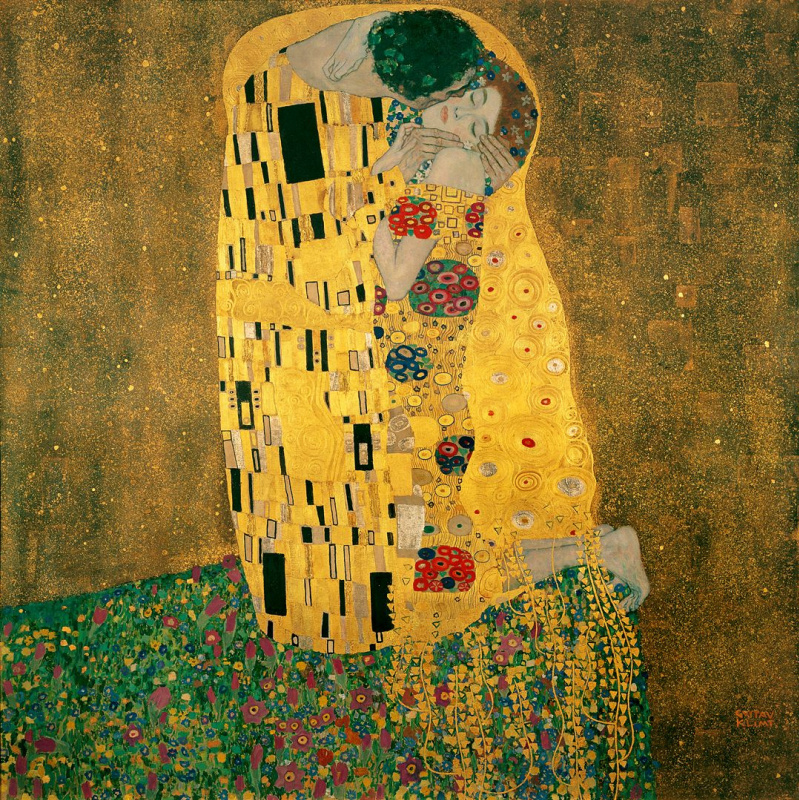log in
Enter site
Login to use Arthive functionality to the maximum
Kiss
Gustav Klimt • Painting, 1908, 180×180 cm
Description of the artwork «Kiss»
You can hardly find a painting as much cited and imitated on a variety of media, sometimes quite unexpected ones, as The Kiss. Cups, bookmarks, calendars and postcards, even kitchen utensils and bed linens. Anyone who has ever been to Vienna, hardly helped the desire to take a souvenir with the image of one of the most famous loving couples in the world.
Gustav Klimt left Vienna very rarely. You can count his trips to Paris on the fingers of one hand. As for the rest of Europe, he seemed to have little interest in it. The only exception was Italy, or rather Ravenna, from where Klimt in 1903 brought his passionate Byzantine mosaics. The use of gold and a variety of ornamental patterns in the works of old masters were reflected in the most productive and bright "Golden Period" of Klimt’s work, in the mature period that gave the world his most famous paintings, including The Kiss.
Ornaments used by the artist to depict the couple merged in a loving embrace, are not accidental. Throughout almost his whole creative career, Klimt tried to convey his vision of the duality of love. Here Gustav Klimt conveys this sensation, in particular, through the differentiation of male and female. The garment of the man in The Kiss is drawn with clear squares and rectangles, while the dress of his lover is decorated with ornamentation, in which the softer and "female" circles and spirals predominate.
There are two more interesting details in The Kiss. First, as in most of his mature works, the artist does not allow the viewer to see the face of the character (Klimt was often blamed for the fact that he was only interested in women; after all, he completely stopped drawing men). And secondly, note that Klimt did not paint the kiss itself on the canvas, but rather its expectation, anticipation. According to one version, the painting was ordered to him by a certain count. He gave the artist a medallion with an image of his beloved and asked to portray them together. But during the work on the painting, Klimt fell in love with the girl from the medallion, quite suddenly for himself. And so instead of the count, Gustav Klimt pictured himself beside her, hiding his face. Therefore the couple on the canvas is not merged into a kiss, but remains in a passionate love longing, in agonizing expectation of the kiss.
Author: Yevheniia Sidelnikova
Gustav Klimt left Vienna very rarely. You can count his trips to Paris on the fingers of one hand. As for the rest of Europe, he seemed to have little interest in it. The only exception was Italy, or rather Ravenna, from where Klimt in 1903 brought his passionate Byzantine mosaics. The use of gold and a variety of ornamental patterns in the works of old masters were reflected in the most productive and bright "Golden Period" of Klimt’s work, in the mature period that gave the world his most famous paintings, including The Kiss.
Ornaments used by the artist to depict the couple merged in a loving embrace, are not accidental. Throughout almost his whole creative career, Klimt tried to convey his vision of the duality of love. Here Gustav Klimt conveys this sensation, in particular, through the differentiation of male and female. The garment of the man in The Kiss is drawn with clear squares and rectangles, while the dress of his lover is decorated with ornamentation, in which the softer and "female" circles and spirals predominate.
There are two more interesting details in The Kiss. First, as in most of his mature works, the artist does not allow the viewer to see the face of the character (Klimt was often blamed for the fact that he was only interested in women; after all, he completely stopped drawing men). And secondly, note that Klimt did not paint the kiss itself on the canvas, but rather its expectation, anticipation. According to one version, the painting was ordered to him by a certain count. He gave the artist a medallion with an image of his beloved and asked to portray them together. But during the work on the painting, Klimt fell in love with the girl from the medallion, quite suddenly for himself. And so instead of the count, Gustav Klimt pictured himself beside her, hiding his face. Therefore the couple on the canvas is not merged into a kiss, but remains in a passionate love longing, in agonizing expectation of the kiss.
Author: Yevheniia Sidelnikova





